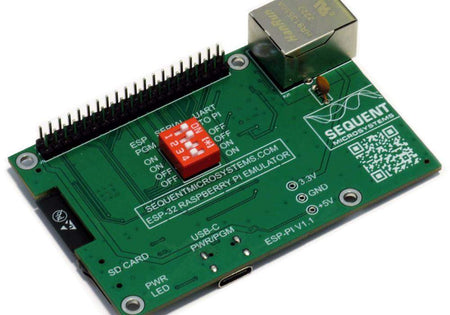







ESP32-Pi: A low cost Raspberry Pi Alternative using ESP32
Emulates 24 GPIO Pins, three UART ports, I2C and SPI, 10/100 Mbps Etherner, WiFi and Bluetooth, USB-C
Sale
In stock
Regular price
$36.00
Sale price
$36.00
Regular price
$45.00
FEATURES
-
Emulates 24 out of 29 Raspberry Pi GPIO pins
-
Pin compatible three UART ports
-
Pin compatible I2C and SPI ports
-
WiFi and Bluetooth (low energy)
-
10/100 Mbps RJ45 Ethernet port
-
On-board SD-Card socket
-
USB Type C port for power, programming and debug
-
ESP32 processor up to 240MHz
-
Power and Ethernet LEDs
-
Arduino and OpenPLC programmable
-
Web Server, MQTT protocols
- Best Raspberry Pi Alternative today
- ECCN Code EAR99
DESCRIPTION
The card has the same dimensions with all Raspberry Pi's equipped with the 2x20 GPIO connector. It has a pin-compatible GPIO connector, accepting all HATs designed for Raspberry Pi (well, maybe most of them. For sure all the Sequent Microsystems HATs)
The ESP32 module has it's own RF antenna, supporting both WiFi and Bluetooth. It has enough IOs to emulate most of the Raspberry GPIOs. We added hardware for an SD-CARD socket connected through an SPI port, an USB-C port which you can use to power the board and to upload and debug your programs, and a 10/100Mbps Port for secure, wired Internet connection. It does not run Linux, it does not have an operating system or an HDMI port, but you can use the Six-in-one LCD Adapter Kit add-on to add a four lines x 20 characters or 2 lines x 16 characters LCD add-on to input values and display variables for your embedded applications.
You can write your applications using the Arduino IDE or OpenPLC. We are in the process of developing OpenPLC blocks for all Sequent Microsystems HATs, which will work seamlessly with this HAT
SIDE BY SIDE COMPARISON
Raspberry Pi has surface mount components on both sides. The ESP32-Pi has SM components only on the bottom. Overall dimensions are identical. The USB port is on the bottom side, slightly moved to te right. The Ethernet port is in the same position. The SD card is on the same side, slightly lower position. The picture below shows the latest fully functional lab prototype which was used to obtain the CE certification.

DOWNLOADS
User's Guide
OpenPLC
APPLICATIONS
1. ARDUINO. Since the processor belongs to the Arduino family, the ESP32-Pi can be programmed using the Arduino Integrated Development (IDE). All Sequent Microsystems HATs have libraries for the Arduino IDE.
Arduino Programming Example
This example shows how to read the inputs and set the outputs of our Home Automation HAT, using this HAT and the LCD Kit with a 2004 display. The source code and be downloaded from GitHub.
2. OpenPLC. The OpenPLC has built-in support for the ESP32-Pi. Applications can be developed using the OpenPLC editor, and the runtime module can be downloaded to the card. OpenPLC supports all five languages defined in the IEC 61131-3 standard: Ladder Logic (LD), Function Block Diagram (FBD), Instruction List (IL), Structured Text (ST), and Sequential Function Chart (SFC).
OpenPLC Programming Example
Coming soon.
Related products
-
 Coming soon
Coming soonBack Panel for Raspberry Pi Industrial Automation - Eight Slot Version
Dedicated Raspberry Pi Slot plus eight I/O expansion slots; 2xRS485, 2xRS232, CAN, RTC, Watchdog. Unlimited expandability. -
 In stock
In stockEight 24-Bit Analog Inputs DAQ 8-Layer Stackable HAT for Raspberry Pi
Eight Differential or Common Ground 24 bit inputs software selectable to ±0.75V, ±1.5V, ±3V, ±6V, ±12V, ±24V with status LEDs; RS485, Watchdog. -
 Coming soon
Coming soonEight MOSFETS with PWM, Current Sense and Digital Inputs for Raspberry Pi Back Panel
Eight MOSFETS with PWM, up to 8A and 240VDC loads, proportional control with current sensing -
 Coming soon
Coming soonBack Panel for Raspberry Pi Industrial Automation - Four Slot Version
Dedicated Raspberry Pi Slot plus four I/O expansion slots; 2xRS485, 2xRS232, CAN, RTC, Watchdog. Unlimited expandability.








